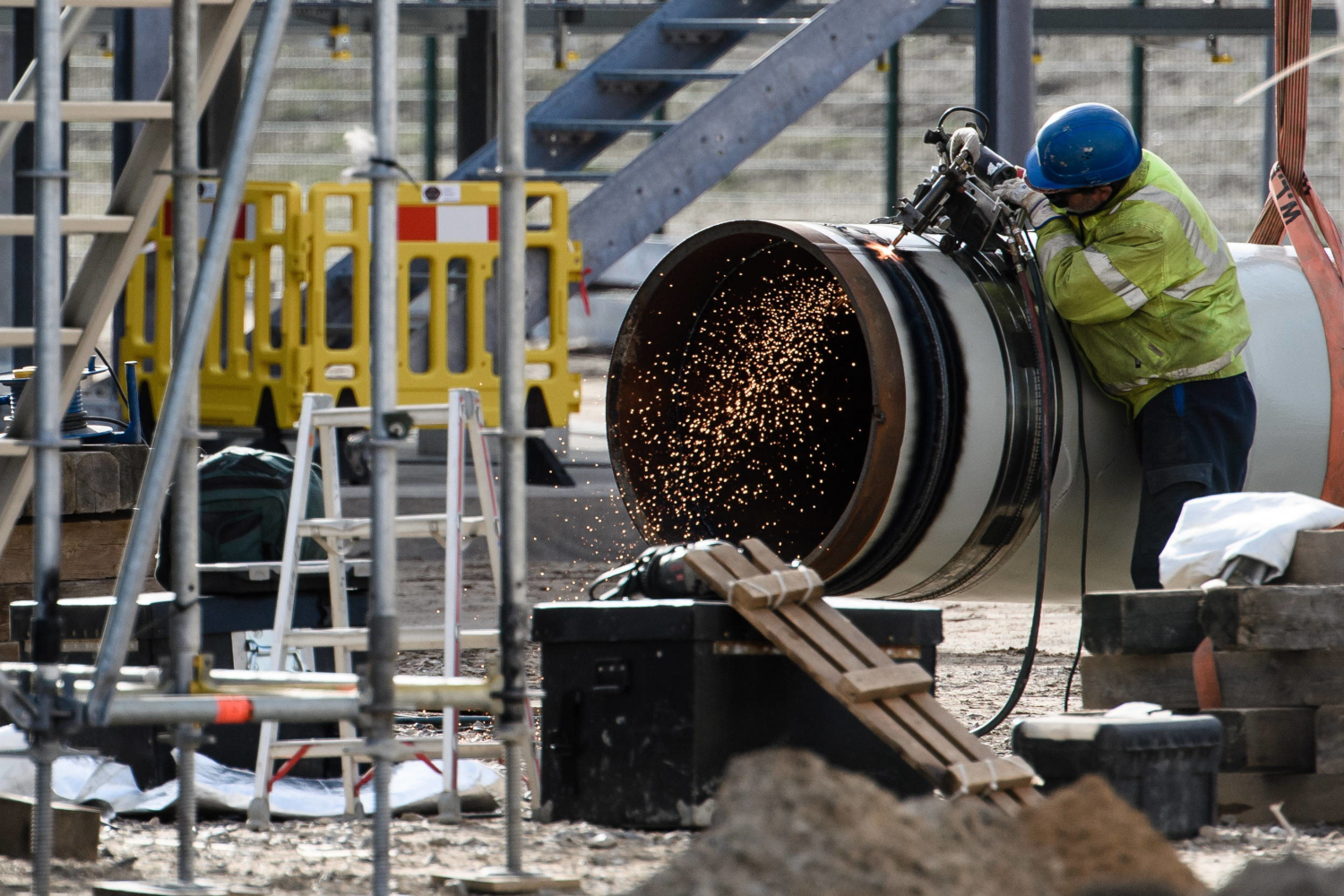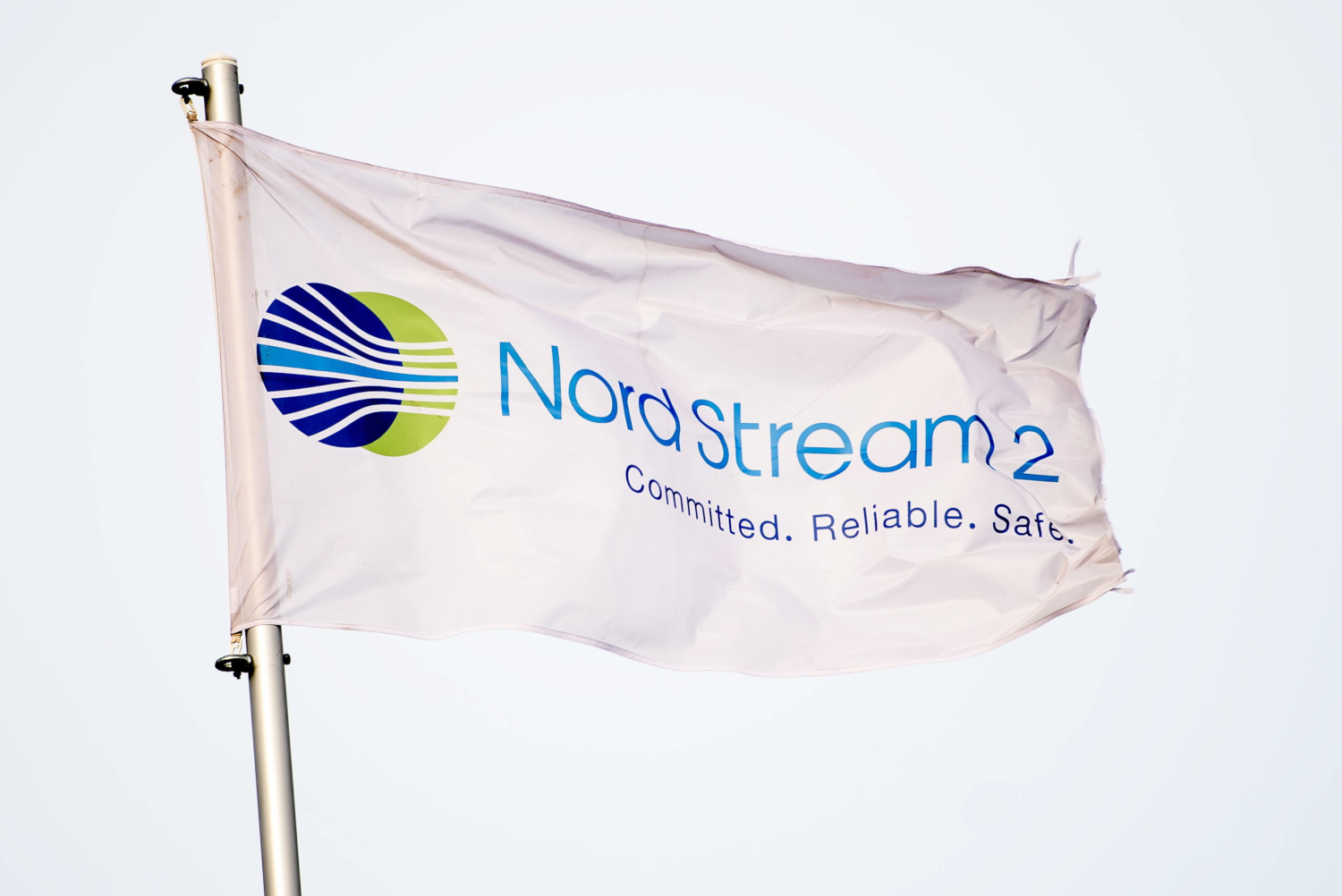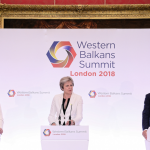THE WARSAW INSTITUTE REVIEW
Date: 10 February 2019 Author: Grzegorz Kuczyński
Nord Stream 2: A Trap for Ukraine
Nord Stream 2 is a political project targeted at Ukraine, among others. It is an essential element of Russia’s anti-Ukrainian strategy and a tool to eliminate Kiev from the European gas transit system. This would be a severe political and financial blow to the Ukrainian state.
 Lubmin, Germany, March 16, 2019. Construction work on Nord Stream 2 in Lubmin, Germany. © Clemens Bilan (PAP/EPA)
Lubmin, Germany, March 16, 2019. Construction work on Nord Stream 2 in Lubmin, Germany. © Clemens Bilan (PAP/EPA)At the end of January 2019, the European Commission, Ukraine, and Russia held trilateral talks in Brussels on maintaining the transit of Russian gas through Ukraine after the expiration of the 2009 agreement. Just like the first round of negotiations in July 2018, this one also cannot be considered a breakthrough. The next one is expected to be held after the presidential elections in Ukraine. Russia is apparently trying to buy some time. All of this is related to the Nord Stream 2 project. The issue of this gas pipeline is closely related to the problem of Russian gas transit through Ukraine.
The Battle of the Gas Pipelines
The Nord Stream 2 pipeline, the construction costs of which are estimated at 9.5 billion euro, will double the capacity of the previously built pipeline from 55 billion m³ to 110 billion m³ per year. This, however, does not mean a sudden increase in Russian gas exports to Europe. The reason is simple: Russia will not have new sources of gas for Europe in the near future. This means that gas pumped by two new branches of the Baltic gas pipeline will not flow along an existing export route. Given that at the end of 2019 the Russian-Ukrainian agreement on the transit of gas through Ukraine ends, it is evident that Gazprom will redirect it to the new Nord Stream 2 gas pipeline. There is a threat of a drastic reduction in the amount of Russian gas exported by the Ukrainian gas pipeline system to the EU and Moldova. For the time being, Ukraine is the leading transit country through which Russian gas flows to Europe. In 2017, it was more than 93 billion m³ (the highest level out of the last seven years), accounting for approximately half of the Russian gas exports to the EU and Turkey. 39% of Europe’s supplies of Russian gas ran through Ukraine.
Launching new pipelines aiming to bypass Ukraine – the second branch of Nord Stream (in the north) and Turkish Stream (in the south) – may, in the worst-case scenario, lead to the halting of Russian gas supplies through the Ukrainian transmission system. To make matters worse, this situation can pose a threat to shipment and complicates the security of gas imports via Ukraine. Back in 2013, Ukraine was Gazprom’s third largest client in terms of the volume of gas purchased – with 22.6 billion m³ per year. In 2017, Ukraine’s total import statistics amounted to 14.1 billion m³, none of which came from Russian suppliers. Gas purchases from Gazprom were halted in 2014, and Ukraine has since then imported most of its supplies from EU countries. In terms of infrastructure, such a solution seems to be both cheap and easy, especially since it is Russian gas that flows into Europe through Ukraine, while in this case intermediary companies almost immediately resell part of the contracted gas to Ukraine. In other words, Naftogaz, de facto, acquires gas just as it used to: it is transported to Ukraine from the east. However, it is no longer directly purchased from Russia’s Gazprom, but from other European energy companies. Similarly, complete or severe restrictions on Russian gas transit will deprive Naftogaz of most of its profits. For instance, in the first three quarters of 2017, Ukraine’s transport and distribution of gas constituted over 90% of its turnout. The CEO of Naftogaz Andriy Kobolyev estimates the company’s annual profit at between 2 and 3 billion dollars, which accounts for 2.5-3 % of Ukraine’s GDP. The nominal capacity of the Ukrainian gas transmission system (GTS) amounts to 142 billion m³ per year. At the end of the last decade, it was not that high – 110 billion m³, which constitutes 80 percent of all Russian gas exports to Europe. Nord Stream 2, however, had a considerable impact on Ukrainian transit. In 2011, it amounted to 104.2 billion m³ of gas. In 2012 and 2013, it decreased to 84-86 billion m³ (about 50% of supplies exports to Europe). A year later, it dropped to 62.2 billion m³ (40 percent of all exports to Europe), and in 2015 to 51 billion m³, accounting for 30 percent of exports. These figures are a result of significant reductions in gas demand in Europe as well as the launch of Nord Stream in 2011, the maximum annual capacity of which was estimated at 55 billion m³. Shipment intensity has begun to increase again in the last couple of years; however, increased demand in Europe is not the only driver behind this shift. This rising trend was not affected by the Russian-Ukrainian conflict: in 2016, its volumes amounted to 82.2 billion m³ and 93.46 billion m³ only a year later, marking 13.7% growth, 90.75 billion m³ of which were transported to the EU market, while 2.71 billion m³ – to Moldova. When it comes to Gazprom, it was forced to make use of Ukrainian services as it needed liquid funds due to western sanctions, the effect of which was a significant reduction of hydrocarbon prices and capital outflow from Russia. Therefore, the company had to sell as much gas as possible to Europe while demand was still growing. Russian gas volumes exported to the European Union amounted to 138 billion m³ in 2010, 158 billion m³ in 2015, and 178 billion m³ in 2016. This result would not be achievable without the Ukrainian gas transmission system. Unsurprisingly, such business turned out lucrative for Kiev, as it collected transit fee profits.
Meanwhile, Russia was still spreading anti-Ukrainian information, accusing its neighbor of unstable and unsafe transit due to the allegedly poor technical condition of Ukrainian gas pipelines. At the same time, Ukraine’s GTS proves to be good enough to function, having proven that it posed no threat to the security of gas supplies to the European Union. The system’s flexibility is considered its most valuable advantage, while persistent large-scale changes in the amount of gas have not affected its operational quality. For example, in September 2017, when Nord Stream was undergoing planned maintenance work, transit through Ukraine increased significantly: amounting to 120 billion m³ (180 million m³ per day) on an annualized basis. However, Russia intends to use the expiration of the current agreement to drastically reduce its transport through Ukraine. In April 2018, CEO of Gazprom Alexei Miller said that once alternative export routes (Nord Stream 2, Turkish Stream) were launched, his company could keep transit through Ukraine after 2019 at only 10-15 billion m³ annually. For Ukraine, this is absolutely unacceptable. In order for the GTS to be profitable, Ukraine should contract no less than 60 billion m³ of gas per year.
Scenarios for Ukraine
Kiev does not stand on a lost position. It can at least be sure of one thing: the current gas deal’s expiration will not bring about any serious problems. At the end of 2019, Russia can neither completely stop its gas transport through Ukraine nor reduce its volumes to 10–15 billion m³ annually, which would be disastrous for Kiev. This may happen as the pipelines intended to bypass the neighbor’s territory will not be ready to supply raw material directly to EU contractors, which have outstanding agreements that have to be delivered on. If the Nord Stream 2 pipeline reaches the German shore in 2019, as it was initially scheduled, yet not at all certain, it is very unlikely that the route will be fully operational. Furthermore, infrastructure delivering gas to Germany and neighboring countries still needs to be expanded upon and launched. This mostly references the EUGAL gas pipeline which runs through Germany. Its completion is scheduled for 2022. Even if it is possible to launch the first phase without any delays, Russia will initially be only able to use Nord Stream 2’s maximum capacity of 34 billion m³, forcing Gazprom to transport up to 40 billion m³ of gas before the pipeline’s second phase becomes functional. Ukraine seems to be completely aware of this, hoping to use it in negotiations with Moscow; for example, by demanding a long-term transit agreement that may guarantee more gas. If Gazprom rejects this, it would have to face the possibility of decreasing a significant amount of its gas export quantity to Europe for two years. The question remains, though, if Russia can afford not to keep their contracts with European recipients.
Given the current situation, provoked by the anticipated expiration date of the Gazprom-Naftogaz deal and the threat of a drastic reduction in gas transit – or even its complete suspension, Ukraine’s authorities, and the company’s management came up with several possible options. The most optimal plan is to block the Nord Stream 2 construction. It seems, however, that Kiev somehow accepted the fact that the project would eventually be implemented, at least given Naftogaz’s official standpoint. On November 4, 2018, the company’s managing director Yuriy Vitrenko admitted that, “it is already impossible to stop the construction of the Nord Stream 2 pipeline,” urging Russia to maintain gas shipment through Ukraine. It can, therefore, be said that the project will be implemented while the German government and companies are eager to back the venture (a plan that is likely to halt gas transit through Ukraine). In view of this, as a member of the Naftohaz management guaranteed, the company is launching a “plan B” which aims to offset as much as possible for the financial losses resulting from the future closure of the transit. Ukraine’s state-owned firm may, therefore, find it difficult to negotiate a fair deal in terms of period, gas volumes and effective tariffs. Gazprom is, therefore, likely to stall for time while postponing any binding decisions until the official results of the spring presidential elections, and, more importantly, the autumn parliamentary ballot. Much will, therefore, depend on a new balance of power in Ukraine.
Ukraine can count on two options to minimize the costs arising from the establishment of Nord Stream 2 and to limit the transit. The first option provides for the highest possible involvement of European partners in the Ukrainian gas sector. In June 2017, UkrTransGaz launched a customs warehouse based on gas storage facilities, enabling gas traders to store natural gas for over 1000 days without customs clearance. Its first potential clients have already appeared. Storing EU gas volumes would guarantee hundreds of millions of dollars of profits for Ukraine. Another solution, even safer from Kiev’s perspective, would perhaps be entrusting its entire gas transmission system to the western consortium within the framework of a long-term agreement. For the Germans and the Dutch, such a solution would yield real economic benefits, giving them authority over gas import starting from the Russian border and being much more profitable than the Gazprom-controlled Nord Stream 2 pipeline. If established, a similar consortium would automatically solve Ukraine’s problems with Gazprom. Another option of minimizing losses stemming from the launch of Nord Stream 2 is an attempt to achieve gas self-sufficiency. Ukraine has the third-largest confirmed gas reserves in Europe currently, ahead of Norway and Russia. However, the country does not make full use of its vast potential. In 2017, Ukraine’s total gas output amounted to 20.5 billion m³ while the United Kingdom, which has lodges that are five times smaller, extracts more than 40 billion m³. Similarly, Norway produces 123 billion m³, with reserves that are two thirds greater than those in Ukraine. This seems to illustrate the potential of Ukraine’s gas production sector, despite the loss of Crimean lodges.
European Disappointment, American Hope
In June 2018, Naftogaz’s managing director, Yuriy Vitrenko, reminded that Germany was putting pressure on Kiev to seal the deal back in 2009. “They did not want to go into details. For them, it was enough to be assured by Gazprom that the contract conformed to European standards. Later, it turned out that it had nothing to do with such regulations, constituting rather a purely Russian approach to these rules. It was a truly neocolonial policy,” Naftogaz’s Facebook page quoted him as saying. It does not come as a surprise that Ukrainian authorities are cautious about any support declarations from Germany, especially as Berlin’s official standpoint appears crucial in the context of the Nord Stream 2’s construction.
“Germany sees Ukraine as a reliable gas transit country and an important trading partner,” Germany’s Minister for Economic Affairs and Energy, Peter Altmaier, declared on May 14, 2018, in Kiev, at a meeting with Ukraine’s Prime Minister, Volodymyr Groysman. “We must develop safeguards in order to continue transit of gas through the territory of Ukraine,” Altmaier said. Four days later, German Chancellor Angela Merkel paid a visit to the Russian city of Sochi. While she stressed the need to preserve gas shipment through Ukraine, Russia’s President, Vladimir Putin, claimed that the implementation of the Nord Stream 2 pipeline did not prevent Russian gas from flowing through Ukrainian territory. More importantly, he added that Russia “will continue gas shipments as long as they are economically justified.”
 Germany, 26 March 2019. A flag reading ‘Nord Stream 2’ on the construction site of the Nord Stream 2 in Lubmin. © Clemens Bilan (PAP/EPA)
Germany, 26 March 2019. A flag reading ‘Nord Stream 2’ on the construction site of the Nord Stream 2 in Lubmin. © Clemens Bilan (PAP/EPA)Last spring, Germany announced its eagerness to help the European Commission in searching for investors for Ukrainian gas pipelines with the aim of “maintaining Russian gas shipment,” followed by multilateral consultations held in Brussels in the summer and in September. Naturally, they did not yield any results. Germany’s offer appeared nothing more than an actual desire to play on time while attempting to delay possible U.S. sanctions. Unofficially, Germany put forward several transit variants, as reported by the Ukrainian media, an example of which was the idea of dividing a separate section of the Urengoy–Pomary–Uzhhorod pipeline, coming from the Kursk corridor direction, that could be then handed over to an external consortium. This may be due to the Berlin’s need to transit 30 billion m³ of gas, annually, through Ukraine before Nord Stream 2 becomes fully operational. Therefore, Germany is not at all interested in other capabilities of Ukraine’s gas transmission system. Partial gas shipments, if maintained, would enable the Germans to admit that they had managed to keep their word while assuring Ukraine that Nord Stream 2 would pose no threat to its transit operations. If someone on the Ukrainian side had any illusions about receiving German aid in matters related to Nord Stream 2 and Russian transit through Ukraine, they probably lost them in November and December 2018. After firing at and seizing Ukrainian warships in the Kerch Strait area, Christian Democrats representative Peter Altmaier stated that the Nord Stream 2 issue should be excluded from the discussion on how to respond to Russian actions in the conflict around Crimea.
Brussels and EU institutions are generally in favor of Ukrainian demands. The problem is that there is probably no other matter in which we can see that European solidarity is a myth, and the last word generally belongs to Berlin. An advocate of keeping Russian transit through Ukraine at a safe level is the deputy head of the European Commission. On May 25, 2018 during a meeting held in Brussels, Maroš Šefčovič stated that “Ukrainian pipelines constitute the most important transport route for Russian gas to be transported to Europe.” He recalled the official position of the European Commission that Ukraine should remain an important transit country for Russian gas also after the expiration of the contract between Naftogaz and Gazprom. However, for the time being, trilateral talks on this issue with the participation of Russia, Ukraine, and the European Commission have not produced any results. For Moscow, the only thing that matters is Berlin’s position on the subject. The Americans openly say that they do not believe in the effectiveness of Germany’s efforts to obtain a guarantee from Russia that the transit of gas to Europe through Ukraine will be maintained. (Sandra Oudkirk from the Department of State: “We do not believe in the effectiveness of such guarantees.”) However, the USA does not offer specific solutions in return. Meanwhile, every month we are closer to finalizing the worst-case scenario for Kiev: Nord Stream 2 is being constructed and Gazprom drastically reduces transit through Ukraine. It seems that the Ukrainians have less and less of a choice: the only option left is focusing on looking for ways to mitigate the consequences of turning off the tap by the Russians. At the same time, it can count on delays in the implementation of Nord Stream 2 and EU legislative actions resulting in a significant increase in the cost of gas supply through the pipeline on the Baltic seabed. The optimal scenario from Kyiv’s point of view (the complete suspension of the construction of the pipeline as a result of sanctions imposed by the USA) seems to be only theoretical.
All texts published by the Warsaw Institute Foundation may be disseminated on the condition that their origin is credited. Images may not be used without permission.














